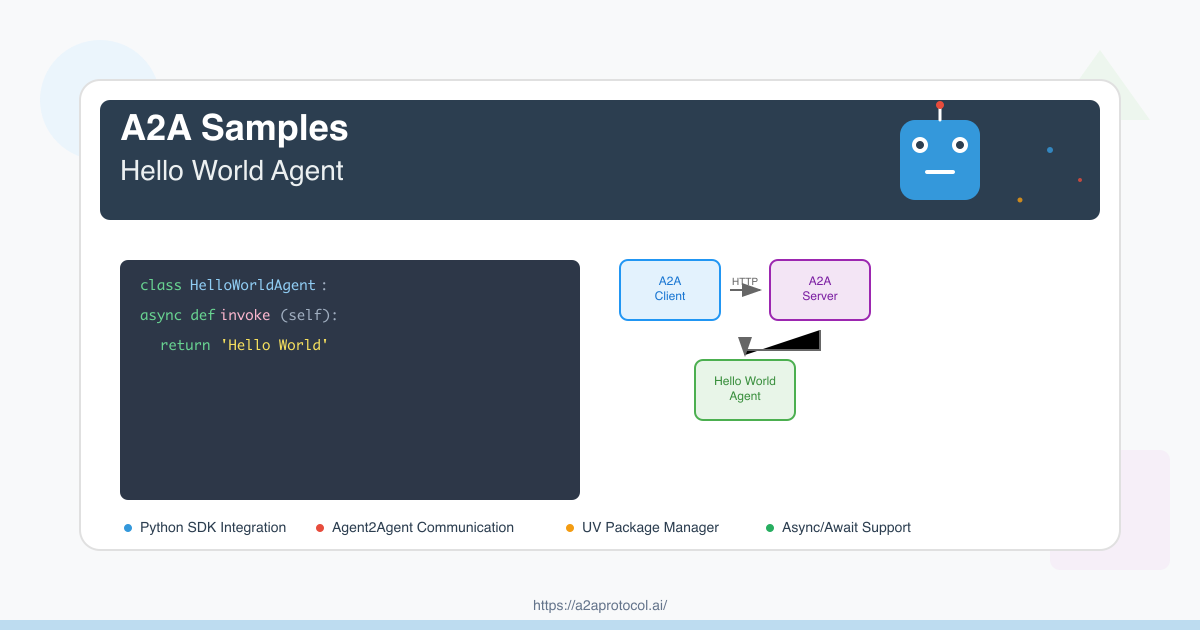
Project Overview
This is a simple Hello World agent example based on the A2A (Agent2Agent) SDK. The project demonstrates how to create a basic intelligent agent server that can respond to user messages and return simple greetings.
Dependency Version Requirements
Python Version Requirements
- Python >= 3.10
Core Dependencies
| Package | Version | Purpose |
|---|---|---|
a2a-sdk |
>= 0.2.5 | A2A core SDK, provides agent framework |
uvicorn |
>= 0.34.2 | ASGI server for running web applications |
click |
>= 8.1.8 | Command line interface tool |
httpx |
>= 0.28.1 | Async HTTP client |
pydantic |
>= 2.11.4 | Data validation and serialization |
python-dotenv |
>= 1.1.0 | Environment variable management |
langchain-google-genai |
>= 2.1.4 | Google Generative AI integration |
langgraph |
>= 0.4.1 | Language graph processing framework |
Project Structure
helloworld/
├── __init__.py # Package initialization file
├── __main__.py # Main program entry point
├── agent_executor.py # Agent executor implementation
├── test_client.py # Test client
├── pyproject.toml # Project configuration and dependencies
├── uv.lock # Dependency lock file
└── README.md # Project documentation
Environment Setup
1. Install UV Package Manager
If you haven't installed UV yet, please install it first:
# macOS/Linux
curl -LsSf https://astral.sh/uv/install.sh | sh
# Or use pip
pip install uv
2. Clone the Project
git clone https://github.com/google-a2a/a2a-samples.git
cd a2a-samples/samples/python/agents/helloworld
3. Install Dependencies
UV will automatically install all dependencies based on pyproject.toml and uv.lock files:
uv sync
Code Architecture
Core Components
1. HelloWorldAgent (agent_executor.py)
class HelloWorldAgent:
"""Hello World Agent."""
async def invoke(self) -> str:
return 'Hello World'
2. HelloWorldAgentExecutor (agent_executor.py)
class HelloWorldAgentExecutor(AgentExecutor):
"""Agent executor implementation"""
async def execute(self, context: RequestContext, event_queue: EventQueue) -> None:
result = await self.agent.invoke()
event_queue.enqueue_event(new_agent_text_message(result))
3. Server Configuration (__main__.py)
- Define agent skills (AgentSkill)
- Configure public and extended agent cards (AgentCard)
- Set up request handlers and task storage
- Start Uvicorn server
Running Steps
1. Start the Agent Server
uv run .
The server will start at http://localhost:9999.
2. Run the Test Client
In another terminal window:
uv run test_client.py
3. Verify the Service
You can verify that the service is running properly through the following methods:
Access Agent Card Information
curl http://localhost:9999/.well-known/agent.json
Access Extended Agent Card (requires authentication)
curl -H "Authorization: Bearer dummy-token-for-extended-card" \
http://localhost:9999/agent/authenticatedExtendedCard
Project Flow Diagram
A2A Client-Server Interaction Flow
sequenceDiagram
participant Client as A2A Client
participant Server as A2A Server
participant Agent as HelloWorldAgent
participant Queue as EventQueue
Note over Client,Server: 1. Service Discovery Phase
Client->>Server: GET /.well-known/agent.json
Server-->>Client: Return public agent card
Note over Client,Server: 2. Extended Card Retrieval (Optional)
Client->>Server: GET /agent/authenticatedExtendedCard<br/>(with Bearer token)
Server-->>Client: Return extended agent card
Note over Client,Server: 3. Message Sending Flow
Client->>Server: POST /agent/message<br/>{"message": {"role": "user", "parts": [...]}}
Note over Server,Queue: 4. Server Internal Processing
Server->>Agent: Call HelloWorldAgentExecutor.execute()
Agent->>Agent: Execute HelloWorldAgent.invoke()
Agent-->>Queue: Generate "Hello World" message
Queue-->>Server: Return event queue result
Note over Client,Server: 5. Response Return
Server-->>Client: Return message response
Note over Client,Server: 6. Streaming Message Processing (Optional)
Client->>Server: POST /agent/message/stream
Server-->>Client: Stream message chunks
Server-->>Client: Message chunk 1
Server-->>Client: Message chunk 2
Server-->>Client: End marker
System Architecture Flow Diagram
graph TB
subgraph "Client Environment"
C1[Test Client Startup]
C2[A2ACardResolver<br/>Parse Agent Card]
C3[A2AClient<br/>Initialization]
C4[Send Message Request]
C5[Process Response]
end
subgraph "Network Communication"
N1[HTTP/HTTPS Request]
N2[JSON Data Transfer]
end
subgraph "Server Environment"
S1[A2AStarletteApplication<br/>Web Server]
S2[DefaultRequestHandler<br/>Request Handler]
S3[HelloWorldAgentExecutor<br/>Agent Executor]
S4[HelloWorldAgent<br/>Core Agent Logic]
S5[InMemoryTaskStore<br/>Task Storage]
S6[EventQueue<br/>Event Queue]
end
subgraph "Agent Configuration"
A1[Public Agent Card<br/>Basic Skills]
A2[Extended Agent Card<br/>Enhanced Skills]
end
%% Client flow
C1 --> C2
C2 --> C3
C3 --> C4
C4 --> C5
%% Network communication
C4 --> N1
N1 --> N2
N2 --> S1
S1 --> N2
N2 --> C5
%% Server flow
S1 --> S2
S2 --> S3
S3 --> S4
S4 --> S6
S6 --> S3
S3 --> S2
S2 --> S1
%% Configuration associations
A1 --> S1
A2 --> S1
S2 --> S5
%% Styling
style C3 fill:#e3f2fd
style S1 fill:#f3e5f5
style S4 fill:#e8f5e8
style N2 fill:#fff3e0
API Endpoints
Public Endpoints
| Endpoint | Method | Description |
|---|---|---|
/.well-known/agent.json |
GET | Get public agent card information |
/agent/message |
POST | Send message to agent |
/agent/message/stream |
POST | Stream message to agent |
Authenticated Endpoints
| Endpoint | Method | Description | Authentication |
|---|---|---|---|
/agent/authenticatedExtendedCard |
GET | Get extended agent card | Bearer Token |
Skill Configuration
Basic Skills
- ID:
hello_world - Name: Returns hello world
- Description: just returns hello world
- Examples: ['hi', 'hello world']
Extended Skills (requires authentication)
- ID:
super_hello_world - Name: Returns a SUPER Hello World
- Description: A more enthusiastic greeting, only for authenticated users
- Examples: ['super hi', 'give me a super hello']
Troubleshooting
Common Issues
-
Port Already in Use
# Check port usage lsof -i :9999 # Kill the process kill -9 <PID> -
Dependency Installation Failed
# Clean cache and reinstall uv cache clean uv sync --reinstall -
Python Version Incompatible
# Check Python version python --version # Ensure version >= 3.10
Extension Development
Adding New Skills
- Define new
AgentSkillin__main__.py - Modify logic handling in
agent_executor.py - Update agent card configuration
Integrating External APIs
- Add new dependencies in
pyproject.toml - Implement API calls in
agent_executor.py - Handle async responses and errors
Summary
This Hello World example demonstrates the basic usage of the A2A SDK, including:
- Creating and configuring agent servers
- Skill definition and management
- Client-server communication
- Authentication and extended functionality
Through this example, you can quickly understand how to build your own intelligent agent applications.